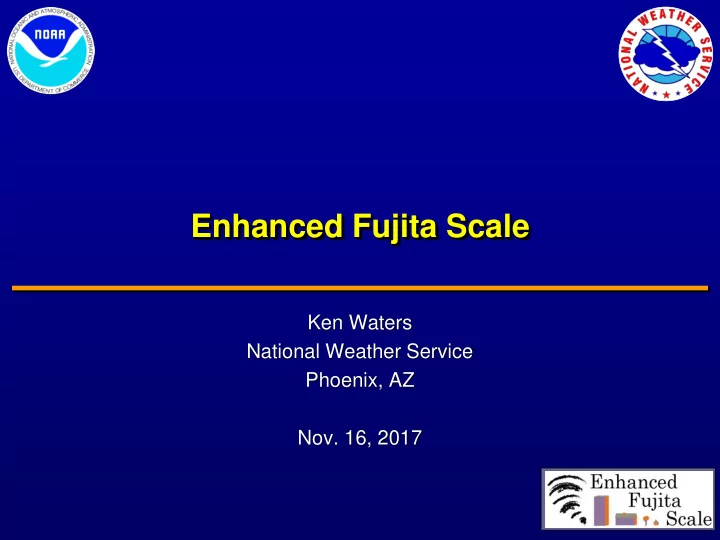

Enhanced Fujita Scale Ken Waters National Weather Service Phoenix, AZ Nov. 16, 2017
Original Fujita Scale • Developed by Dr. T. Theodore Fujita 1971 and published as “Proposed Characterization of Tornadoes and Hurricanes by Area and Intensity” – F0 (Gale) – F1 (Weak) – F2 (Strong) – F3 (Severe) – F4 (Devastating) – F5 (Incredible) • Categorized by area and intensity with an estimated wind speed • Became the standard for tornado ratings in 1974
Original Fujita Scale
Fujita Scale • F0 • 40-72 mph Next 6 slides courtesy Wikipedia
Fujita Scale • F1 • 73-112 mph
Fujita Scale • F2 • 113-157 mph
Fujita Scale • F3 • 158-206 mph
Fujita Scale • F4 • 207-260 mph
Fujita Scale • F5 • 261-318 mph
Limitations • Subjective based solely on the damage caused by a tornado • No recognition in difference in construction • Difficult to apply with no damage indicators – if the 3/4-mile wide tornado does not hit any structures, what F-scale should be assigned? • Based on the worst damage (even if it is one building or house) • Overestimates wind speeds greater than F3 • Too much reliance on the estimated wind speeds • Oversimplification of the damage description • Unrecognizing weak structures – mobile homes – modified homes
New Enhanced Fujita Scale (EF) • Developed from 2000 to 2004 by cross-disciplinary experts and scientists • First used in 2007
Why the EF-Scale was created • Need more damage The framed house is one of only a few F-scale damage indicators. indicators • recalibrate winds associated with F-scale ratings • better correlate wind and rating • account for construction Evidence indicates a well constructed house can be blown variability away by winds much less than • Flexibility, Extensibility, 260 mph ( Phan and Simiu,2003) . Expandability
The forum identifies EF-Scale development strategies • Identify additional Damage Indicators (DI)s • Correlate damage to wind speed – Degrees of Damage (DOD) for each DI • Preserve the historical database • Seek input from users • Maximize usability Objectives: 2, Methodology
EF-Scale Damage Indicators (DIs) • 28 DIs were identified by the Steering Committee • DIs and DODs can be added or modified • Each DI has several Degrees of Damage (DOD) Framed house Single wide mobile home Small Retail Building
28 Damage Indicators Residences Commercial/retail structures Schools Professional buildings Metal buildings/canopies Towers/poles Vegetation Objectives: 3, EF-Scale structure
Degrees of Damage DOD Damage Description EXP LB UB 1 Threshold of visible damage ? ? ? 2 Loss of roof covering material (<20%), gutters and/or awning; loss of vinyl or metal siding 3 Broken glass in doors and windows 4 Uplift of roof deck and loss of significant roof covering material (>20%); collapse of chimney; garage doors collapse inward or outward; failure of porch or carport 5 Entire house shifts off foundation 6 Large sections of roof structure removed; most walls remain standing 7 exterior walls collapsed 8 Most walls collapsed except small interior rooms. 9 All walls collapsed 10 Destruction of engineered and/or well constructed residence; slab swept clean DOD for a Framed House, FR12 or DOD2
F-Scale Converted to EF-Scale F Scale Wind Speed EF-Scale Wind Speed F0 45-78 EF0 65-85 F1 79-117 EF1 86-109 F2 118-161 EF2 110-137 F3 162-209 EF3 138-167 F4 210-261 EF4 168-199 F5 262-317 EF5 200-234 Wind speeds in mph, 3-second gust Objectives: 3, EF-Scale structure; 4, EF vs F-Scale
Strengths of EF-Scale • EF-Scale • F Scale – 28 DIs – Only a Couple DIs – Accounts for differences of – No accounting for differences of structural integrity within a DI structural integrity within a DI – Wind speeds determined from – Wind speeds not derived from damage damage – Continuity from the F-scale – Expandibility, Flexibility, Extensibility Objectives: 5, EF-Scale strengths
EF-Scale limitations • Change in scale may introduce artifacts into the historical record • Complicated • Wind speeds subject to change for each rating • No function relating wind speed to rating • Debate continues about wind speed assignments Objectives: 6, EF-Scale limitations
EF-Scale Tools A Recommendation for the The EFkit Enhanced Fujita Scale http://www.spc.noaa.gov/efscale/ http://wdtd.noaa.gov/courses/ef-scale
EF kit 2008 Files • Download from this site: http://wdtd.noaa.gov/courses/ef-scale • Make sure you have EFkit folder unzipped • In the EFkit folder, double click on EFkit.exe Software developed by Ed Mahoney, WDTD Image library compiled by Kishor Mehta, TTU Simulated images by Matt Murnan, WDTD
Rating a DI with the EF-Scale • Match the description FR12, DOD 7: Exterior Walls Collapsed, 132 mph, EF3 and/or pictures with the damage you see • Expected wind = structure adhering to code • Example: For FR12, what construction is normal (benchmark)? FR12, DOD 6: Large Section of roof removed, most walls standing, 122 mph, EF2
Accounting for construction quality in F vs EF • F-scale paradigm • EF-Scale paradigm • If structure is weaker • If structure is weaker (stronger) than standard, (stronger) than standard, consider dropping (raising) lower (raise) wind speed F-scale toward the LB (UB) and then see if that lowers (raises) the EF rating. Lower the rating EF 2
A strategy for surveying tornado tracks with the EF-Scale • Identify DIs first with LIRB: DOD 6: Inward, outward collapse of exterior walls. broad survey Expected wind = 137 mph EF3 • Carefully rate DODs for chosen DIs • Use the highest rated DIs to help rate the FR12: DOD7: Exterior walls tornado collapsed. Expected wind = 132 mph, EF2 http://wdtd.noaa.gov/courses/EF- scale/lesson2/FinalNWSF- scaleAssessmentGuide.pdf
Additional Information • Texas Tech Wind Science Engineering Center: http://www.depts.ttu.edu/nwi/Pubs/FScale/EFScale.pdf • A Guide to F-Scale Damage Assessment http://www.wdtd.noaa.gov/courses/EF-scale/lesson2/FinalNWSF- scaleAssessmentGuide.pdf • EFKIT: http://wdtd.noaa.gov/courses/ef-scale • Storm Prediction Center: http://www.spc.noaa.gov/efscale/ • Training Package: http://training.weather.gov/wdtd/courses/EF- scale/index.html
Recommend
More recommend